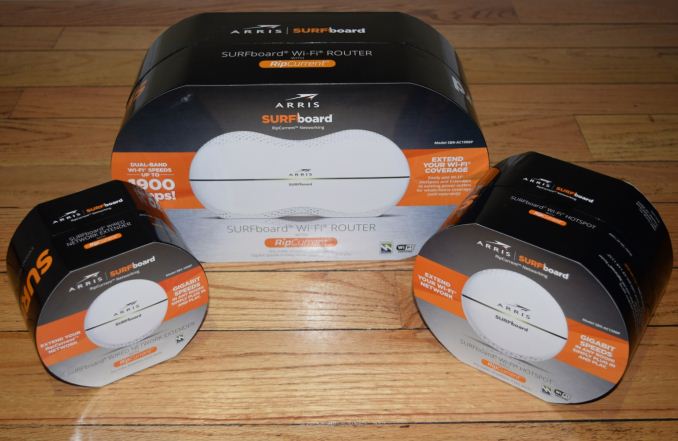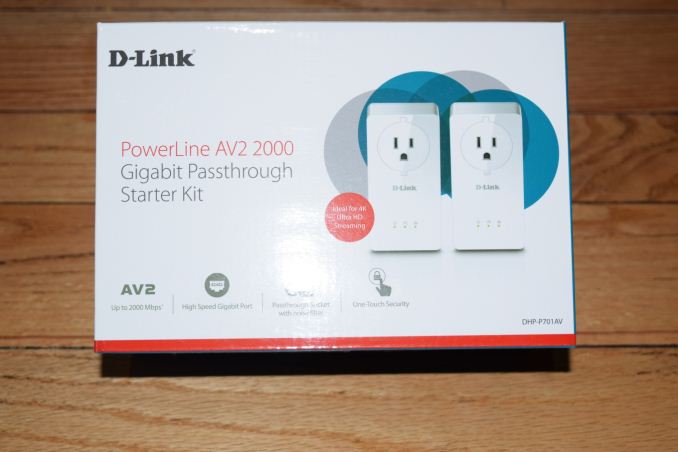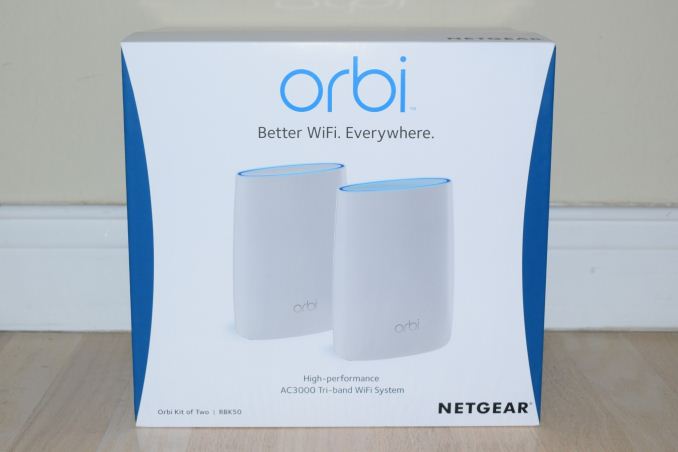Extending Home Networks - A Comparison of G.hn, HomePlug AV2 and Wi-Fi Mesh
by Ganesh T S on December 7, 2016 8:00 AM ESTEvaluation Methodology and Tested Configurations
The benchmarks processed for this article were aimed at determining the effectiveness of kits in extending the reach of the home networks. Therefore, it was an evaluation of the backhaul, rather than performance with client devices themselves.
The ARRIS RipCurrent product lineup is the most comprehensive suite in the market when it comes to hybrid networking. The following products were used in our evaluation:
- ARRIS SURFboard AC1900 Wi-Fi Router with RipCurrent using G.hn (SBR-AC1900P)
- ARRIS SURFboard AC1200 Wi-Fi Hotspot with RipCurrent using G.hn (SBX-AC1200P)
- ARRIS SURFboard Wired Network Extender with RipCurrent using G.hn (SBX-1000P)
Our review of the Comtrend G.hn powerline networking kit compared the first-generation Marvell G.hn chipset with various HomePlug chipsets from Qualcomm Atheros and Broadcom. The highest-end HomePlug AV2 chipset used in that review was the Qualcomm Atheros QCA7500 in the ZyXEL PLA5405 (AV1200-class). This chipset uses only the 0-65MHz band with MIMO, limiting the performance compared to what the HomePlug AV2 specifications allow. HomePlug contacted us with a suggestion to compare against an AV2 2000-class HomePlug AV2 product. D-Link provided us with the DHP-P701AV passthrough kit for this purpose.
In terms of testing wired backhauls using power lines, a comparison of the ARRIS SURFboard router and wired network extender (SBR-AC1900P + SBX-1000P) and the D-Link DHP-P701AV kit can show the effectiveness of G.hn and HomePlug AV2 for extending network reach.
In addition to the hardware made up of standard building blocks (Wi-Fi radios and router SOCs), Qualcomm Atheros's Wi-Fi SON is also a collection of software features. Different customers implement it differently. QCA told us that, as of Q4 2016, Netgear's Orbi is the best example because they use the whole package, while vendors like Luma, Google and eero all use some of the Wi-Fi SON features. Netgear provided us with the Orbi kit (RBK50-100NAS) to test out some of the features of Wi-Fi SON.
A comparison of the ARRIS SURFboard router and Wi-Fi hotspot (SBR-AC1900P + SBX-AC1200P) and the Netgear Orbi presents readers with data to make a decision between Wi-Fi and PLC as backhaul candidates for extending home network reach.
The evaluation of the backhaul in different cases was carried out in a 1800 sq. ft. single-level detached California residence built in the 1970s. The rough floorplan of the house, along with the testing locations, is presented below.
The kits were configured in an isolated network. In the case of routers (the ARRIS SBR-AC1900P and the Netgear Orbi), the setup was quite straightforward with a NUC with an Intel NIC connected to one of the LAN ports. At the other end, we had another NUC with an Intel NIC connected to the wired port of the Wi-Fi hotspot / wired network extender (n the case of the ARRIS kit) or one of the LAN ports on the satellite (in the case of the Netgear Orbi). Since the routers were set up by default to act as DHCP servers, there was no special configuration needed to get IPs allocated to the NUCs at either endpoint. In the case of the D-Link DHP-P701AV, we configured the NUC connected to the adapter at the master location ('M' in red, in the above picture) to act as a DHCP server.
The location of the other endpoint was varied based on two factors - powerline adapter usage scenarios, and, electrical outlet locations that could be used to address typical Wi-Fi dead spots. Six different locations were tested (A - F in green in the picture above). All major rooms, including the garage, were covered.
The purpose of our benchmarking was not to tune the stream configuration for obtaining maximum possible bandwidth. Rather, we wanted to replay the same stream for multiple adapter sets in order to determine comparative performance. iperf with default parameters was used for benchmarking. On the 'server', we ran the following command:
TCP: iperf -s -B 10.1.1.2
UDP: iperf -s -u -B 10.1.1.2
The 'client' was connected to it using the following command:
TCP: iperf -c 10.1.1.2 -P ${num_parallel_streams} -t 30
UDP: iperf -c 10.1.1.2 -u -b ${curr_bw_to_test}m -t 30
The number of parallel streams were tested between 20 and 25 for the TCP case. The maximum obtained bandwidth was recorded. For the UDP case, we altered the bandwidth to test in order to arrive at the value that resulted in less than 1% packet loss during transmission. The roles of the server and client were then reversed, and the same benchmarks were processed.














56 Comments
View All Comments
nedjinski - Wednesday, December 7, 2016 - link
Is Google's recently announced Wi-Fi / OnHub too late to be included in this article? Or is a different type of system?nedjinski - Wednesday, December 7, 2016 - link
http://www.theverge.com/2016/12/6/13843536/google-...J_D - Wednesday, December 7, 2016 - link
http://arstechnica.com/gadgets/2016/12/review-comp...Meteor2 - Tuesday, December 13, 2016 - link
Thanks for those links; good reviews. Orbi boasts best performance, but Google WiFi clearly wins with good design and user experience, and adequate performance.Sailor23M - Saturday, December 10, 2016 - link
Problem with getting a google system is that I suspect that it will "phone home" on everything I do on the internet.iamlilysdad - Wednesday, December 7, 2016 - link
The benchmarks processed for this article were aimed at determining the effectiveness of kits in extending the reach of the home networks. Therefore, it was an evaluation of the backhaul, rather than performance with client devices themselves.^^^ Is there an upcoming article that addresses real world performance and use for client devices? Seems that is ultimately what needs to be measured since that is the entire user experience. I don't care about backhaul capability if the device fails to provide adequate performance to the devices that I connect to it.
melgross - Wednesday, December 7, 2016 - link
This is all very nice, but that house is very easy to do. Older houses are much more difficult.My house was built in 1925. It's two floors. The ceilings are wood lath, with steel mesh holding 3/4 inch mortar with 1/4 inch plaster with numerous layers of paint, the older layers are lead based (well contained). The walls are mostly brick with the above lath, etc. This is very difficult.
While most of the house was wired by myself years ago with CAT 5e, there's a problem. For some reason, my FIOS router doesn't allow (though the instructions says it does, word out is that it's buggy) multiple Ethernet connections for the extenders, for wifi, though Ethernet works just fine, even when I do exactly what the manual says to do. So I tried to use the extenders through my main Apple router, but no go. More than one wifi router wired directly, or through the main apple unit turn the internet signal off at the gateway. Weird! This all worked perfectly with the old gateway with COVAD, so I don't think it's anything I'm doing wrongly.
Because of this, I'm forced to use 4 Apple routers around the house, and I get 155/155 near the main router and with the one in the living room, but then it falls to 30/30, and even lower to below 20/20. Since FIOS is 150/150, or a bit higher, it's frustrating.
So the question here is not how well these do in cheaply built 70's bousing, but in older housing that much less easy for signal throughput. We really need these things tested under more serious conditions.
BrokenCrayons - Wednesday, December 7, 2016 - link
Your home situation sort of started me thinking. One older home I lived in had a wood burning stove as its primary heat source. It was part of the original design, but an oil burning forced air furnace was later added. In any event, in the original design, several grated holes were placed in the ceiling of the first floor to ensure heat from the stove would reach the second floor.You could do something similar with your home by cutting open the floors and the walls to install wireless friendly passages that help signals travel more freely. If I was on anything faster than a 12mbps down and 768kbps up DSL link, I'd seriously consider doing the same because there's nothing worse than having a downstream connection that's faster than your local network. A few window-sized holes in the right walls and floors could vastly improve your situation.
melgross - Wednesday, December 7, 2016 - link
Yes. That's very funny. Cutting windows sized holes throughout the house would add to air flow as well.BrokenCrayons - Thursday, December 8, 2016 - link
I'm not suggesting you just grab some tools and start chopping. To retain house value, you probably should ensure the job is done professionally and the holes are dressed to look appealing to the eye. In my mind, fast network access is worth the trouble of doing some modifications. Besides, the wireless-friendly nature of your home after modifications are completed will probably drive up its resale value to potential buyers that are upset about the same problems your're experiencing now.The other alternative, depending on your financial situation, is just to unload that house on the market and move into newer construction that can handle modern needs. Though older homes have a certain rustic and quaint appeal, we really should be demolishing buildings made before lead regulations were put in place to get rid of those unsightly old structures. Modern houses are a lot more energy efficient anyway and it's really irresponsible for us to keep anything that was built before the 1990s up and working. Such places are ultimatly wasteful and unfit for human habitation due to a variety of health hazards introduced during their construction.